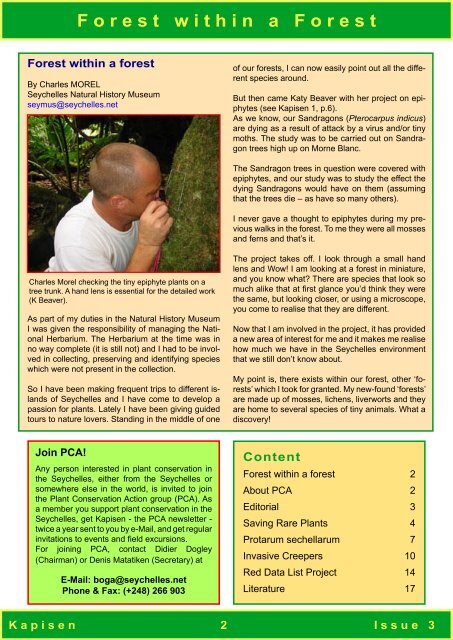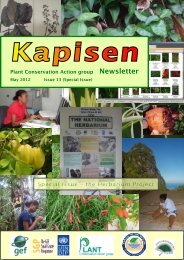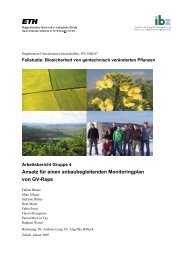Kapisen - ETH Zürich
Kapisen - ETH Zürich
Kapisen - ETH Zürich
Create successful ePaper yourself
Turn your PDF publications into a flip-book with our unique Google optimized e-Paper software.
F o r e s t w i t h i n a F o r e s t<br />
Forest within a forest<br />
By Charles MOREL<br />
Seychelles Natural History Museum<br />
seymus@seychelles.net<br />
Charles Morel checking the tiny epiphyte plants on a<br />
tree trunk. A hand lens is essential for the detailed work<br />
(K Beaver).<br />
As part of my duties in the Natural History Museum<br />
I was given the responsibility of managing the National<br />
Herbarium. The Herbarium at the time was in<br />
no way complete (it is still not) and I had to be involved<br />
in collecting, preserving and identifying species<br />
which were not present in the collection.<br />
So I have been making frequent trips to different islands<br />
of Seychelles and I have come to develop a<br />
passion for plants. Lately I have been giving guided<br />
tours to nature lovers. Standing in the middle of one<br />
Join PCA!<br />
Any person interested in plant conservation in<br />
the Seychelles, either from the Seychelles or<br />
somewhere else in the world, is invited to join<br />
the Plant Conservation Action group (PCA). As<br />
a member you support plant conservation in the<br />
Seychelles, get <strong>Kapisen</strong> - the PCA newsletter -<br />
twice a year sent to you by e-Mail, and get regular<br />
invitations to events and field excursions.<br />
For joining PCA, contact Didier Dogley<br />
(Chairman) or Denis Matatiken (Secretary) at<br />
E-Mail: boga@seychelles.net<br />
Phone & Fax: (+248) 266 903<br />
of our forests, I can now easily point out all the different<br />
species around.<br />
But then came Katy Beaver with her project on epiphytes<br />
(see <strong>Kapisen</strong> 1, p.6).<br />
As we know, our Sandragons (Pterocarpus indicus)<br />
are dying as a result of attack by a virus and/or tiny<br />
moths. The study was to be carried out on Sandragon<br />
trees high up on Morne Blanc.<br />
The Sandragon trees in question were covered with<br />
epiphytes, and our study was to study the effect the<br />
dying Sandragons would have on them (assuming<br />
that the trees die – as have so many others).<br />
I never gave a thought to epiphytes during my previous<br />
walks in the forest. To me they were all mosses<br />
and ferns and that’s it.<br />
The project takes off. I look through a small hand<br />
lens and Wow! I am looking at a forest in miniature,<br />
and you know what? There are species that look so<br />
much alike that at first glance you’d think they were<br />
the same, but looking closer, or using a microscope,<br />
you come to realise that they are different.<br />
Now that I am involved in the project, it has provided<br />
a new area of interest for me and it makes me realise<br />
how much we have in the Seychelles environment<br />
that we still don’t know about.<br />
My point is, there exists within our forest, other ‘forests’<br />
which I took for granted. My new-found ‘forests’<br />
are made up of mosses, lichens, liverworts and they<br />
are home to several species of tiny animals. What a<br />
discovery!<br />
Content<br />
Forest within a forest 2<br />
About PCA 2<br />
Editorial 3<br />
Saving Rare Plants 4<br />
Protarum sechellarum 7<br />
Invasive Creepers 10<br />
Red Data List Project 14<br />
Literature 17<br />
K a p i s e n 2 I s s u e 3







